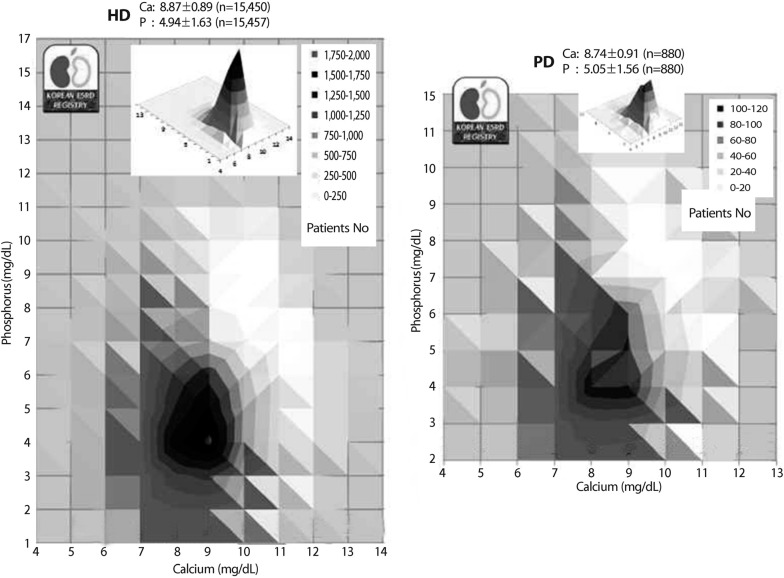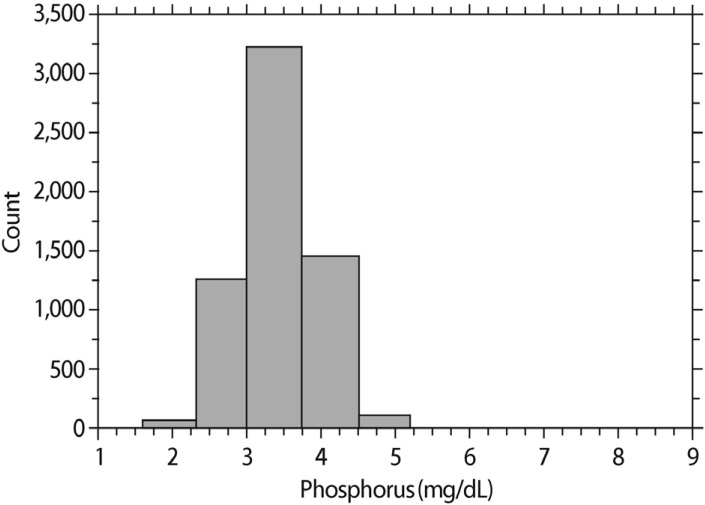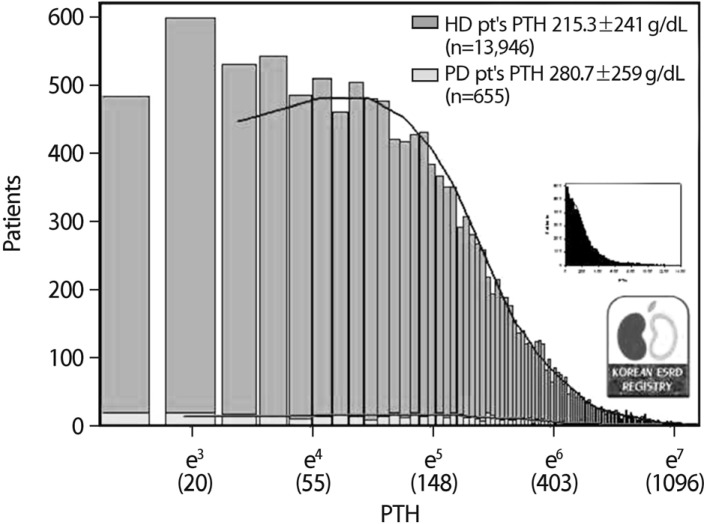Electrolyte Blood Press.
2014 Dec;12(2):35-40. 10.5049/EBP.2014.12.2.35.
Gaps between Global Guidelines and Local Practices in CKD-MBD
- Affiliations
-
- 1Department of Internal Medicine, Hanyang University College of Medicine, Seoul, Korea. kimgh@hanyang.ac.kr
- KMID: 2052330
- DOI: http://doi.org/10.5049/EBP.2014.12.2.35
Abstract
- The term 'chronic kidney disease-mineral bone disorder' (CKD-MBD) is a new term that, in contrast to the old term 'renal osteodystrophy', implies a systemic syndrome associated with cardiovascular morbidity and mortality. This new terminology is in line with previous studies that show elevated serum calcium, phosphorus, and parathyroid hormone (PTH) levels associated with increased cardiovascular and all-cause mortality. In order to improve outcomes in patients with CKD-MBD, many countries have developed clinical practice guidelines. Globally, the Kidney Disease Outcome Quality Initiative (KDOQI) and Kidney Disease: Improving Global Outcomes (KDIGO) guidelines are the most commonly used. However, whether these global guidelines can be successfully implemented on a local level needs to be studied. Differences in medical care and social factors between countries may limit the generalizability of global guidelines. Reports from the Korean registry and the Dialysis Outcomes and Practice Patterns Study (DOPPS) suggest that many dialysis patients are not within the target ranges recommended by the KDOQI and KDIGO guidelines for serum calcium, phosphorus, and PTH, suggesting gaps between global guidelines and local practices. Clinical studies with Korean CKD-MBD patients are necessary to compare Korean practices and outcomes to those suggested by global guidelines and to determine the target serum mineral levels associated with the best local outcomes.
Keyword
MeSH Terms
Figure
Reference
-
1. Current renal replacement therapy in Korea 2013. http://www.ksn.or.kr/journal/2014/index.html.2. Moe S, Drueke T, Cunningham J, Goodman W, Martin K, Olgaard K, Ott S, et al. Definition, evaluation, and classification of renal osteodystrophy: a position statement from Kidney Disease: Improving Global Outcomes (KDIGO). Kidney Int. 2006; 69:1945–1953. PMID: 16641930.
Article3. Abe M, Okada K, Soma M. Mineral metabolic abnormalities and mortality in dialysis patients. Nutrients. 2013; 5:1002–1023. PMID: 23525083.
Article4. National Kidney Foundation. K/DOQI clinical practice guidelines for bone metabolism and disease in chronic kidney disease. Am J Kidney Dis. 2003; 42(4 Suppl 3):S1–S201. PMID: 14520607.5. Kidney Disease. Improving Global Outcomes (KDIGO) CKD-MBD Work Group: KDIGO clinical practice guideline for the diagnosis, evaluation, prevention, and treatment of Chronic Kidney Disease-Mineral and Bone Disorder (CKD-MBD). Kidney Int. 2009; 113(Suppl):S1–S130.6. Fukagawa M, Yokoyama K, Koiwa F, Taniguchi M, Shoji T, Kazama JJ, et al. Clinical practice guideline for the management of chronic kidney disease-mineral and bone disorder. Ther Apher Dial. 2013; 17:247–288. PMID: 23735142.
Article7. Bringhurst FR, Demay MB, Krane SM, Kronenberg HM. Bone and mineral metabolism in health and disease. In : Longo DL, Fauci AS, Kasper DL, Hauser SL, Jameson JL, Loscalzo J, editors. Harrison's Principles of Internal Medicine. 18th ed. McGraw-Hill.8. Gutiérrez OM, Anderson C, Isakova T, Scialla J, Negrea L, Anderson AH, Bellovich K, Chen J, Robinson N, Ojo A, Lash J, Feldman HI, Wolf M. CRIC Study Group. Low socioeconomic status associates with higher serum phosphate irrespective of race. J Am Soc Nephrol. 2010; 21:1953–1960. PMID: 20847142.
Article9. Noordzij M, Korevaar JC, Boeschoten EW, Dekker FW, Bos WJ, Krediet RT. Netherlands Cooperative Study on the Adequacy of Dialysis (NECOSAD) Study Group. The Kidney Disease Outcomes Quality Initiative (K/DOQI) Guideline for Bone Metabolism and Disease in CKD: association with mortality in dialysis patients. Am J Kidney Dis. 2005; 46:925–932. PMID: 16253734.
Article10. Kim GH, Choi BS, Cha DR, Chee DH, Hwang E, Kim HW, et al. Serum calcium and phosphorus levels in patients undergoing maintenance hemodialysis: A multicentre study in Korea. Kidney Res Clin Pract. 2014; 33:52–57.
Article11. Tentori F, Blayney MJ, Albert JM, Gillespie BW, Kerr PG, Bommer J, et al. Mortality risk for dialysis patients with different levels of serum calcium, phosphorus, and PTH: the Dialysis Outcomes and Practice Patterns Study (DOPPS). Am J Kidney Dis. 2008; 52:519–530. PMID: 18514987.
Article12. Fukagawa M, Akizawa T. How to apply and adapt international guidelines on bone metabolism and disease to the management of Japanese dialysis patients. Ther Apher Dial. 2005; 9:1–2. PMID: 15828896.
Article13. Taniguchi M, Fukagawa M, Fujii N, Hamano T, Shoji T, Yokoyama K, et al. Serum phosphate and calcium should be primarily and consistently controlled in prevalent hemodialysis patients. Ther Apher Dial. 2013; 17:221–228. PMID: 23551679.
Article14. KDIGO announces Controversies Conference on CKD-MBD. http://kdigo.org/home/2013/07/19/kdigo-announces-controversies-conference-on-ckd-mbd/.15. Tentori F, Fuller DS, Port FK, Bieber BA, Robinson BM, Pisoni RL. The DOPPS practice monitor for US dialysis care: potential impact of recent guidelines and regulatory changes on management of mineral and bone disorder among US hemodialysis patients. Am J Kidney Dis. 2014; 63:851–858. PMID: 24613057.
Article
- Full Text Links
- Actions
-
Cited
- CITED
-
- Close
- Share
- Similar articles
-
- Osteoporosis in Patients with Chronic Kidney Disease
- Clinical Utility of Bone Turnover Markers in Chronic Kidney Disease
- Diagnosis and Management of Chronic Kidney Disease-Mineral Bone Disease in Children
- Vascular Calcification in Chronic Kidney Disease: Distinct Features of Pathogenesis and Clinical Implication
- Current Understanding of Mineral and Bone Disorders of Chronic Kidney Disease and the Scientific Grounds on the Use of Exogenous Parathyroid Hormone in Its Management




